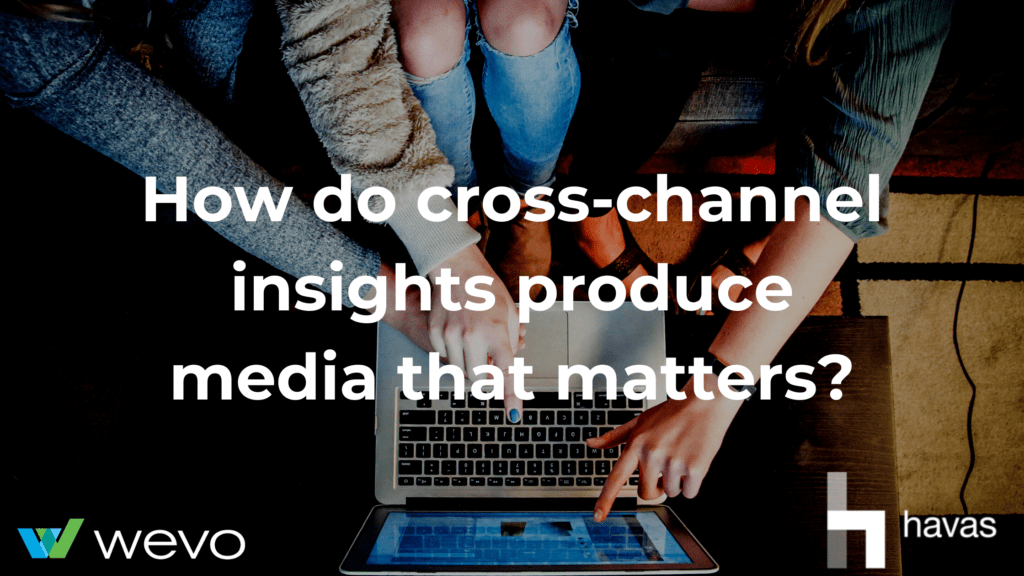Contents
- 1 What kind of work does the Havas’ media analytics team focus on?
- 1.1 Measuring the impact of meaningful media experiences
- 1.2 Pinpointing where visitors are in their digital journey
- 1.3 Connecting the right ad to the right landing page, and vice versa
- 1.4 What methods and tools do you use to gather insights and inform ad messaging?
- 1.5 Factoring in the different channel experiences of a user
- 1.6 The importance of different audience segments and personas
- 1.7 Signs of disconnect in a media campaign
- 1.8 Signals that a campaign journey is fluid and successful
- 1.9 Brands approaching media campaigns the right way
- 1.10 What media campaign trends do you see coming?
For the latest episode of our Qualt Q&A video series, WEVO’s Jenni Bruckman spoke with Parvati Vaish, VP, Director of Analytics at Havas Media Group, about delivering meaningful media experiences to your target audience.
Watch the full episode and read on for key insights from the conversation.
What kind of work does the Havas’ media analytics team focus on?
Two main areas: The first is understanding the efficacy of media investments and optimizing using key engagement KPIs. The second area is uncovering consumer insights within the data.
Measuring the impact of meaningful media experiences
Parvati’s main priority is keeping track of how media campaigns perform against channel KPIs. More holistically, she evaluates the three Cs that define meaningful media — content, context and connection.
“We can only deliver meaningful media experiences if we have the right content, in the right context, while connecting with the right audience. We need to understand where we can optimize on the three Cs, but also make sure the three C combination is effective across channels.” -Parvati
Meaningful media experiences must tie back to business goals, not just marketing goals.
“We start with a businessKPI, like revenue and then take it down a step to brand awareness and content engagement metrics. Then we analyze how media is supporting all these KPIs. Our approach is to define what’s meaningful first and then build toward cross-channel efficacy.” -Parvati
Pinpointing where visitors are in their digital journey
Online consumers are aware data is being collected on them. In return, they expect relevant ads and a personalized experience.
To deliver on this trade off, Havas’ analytics team keeps a close eye on their audience’s website visit activity, search behavior, the types of content they consume, and semantic analysis.
“Using this data from first-party sources, partner insights and our syndicated tools, we look for how far along consumers are in their purchase journey. We use those signals to develop our content, messaging and placement.” -Parvati
Connecting the right ad to the right landing page, and vice versa
“High website engagement is our primary indicator of a well thought out user flow. We implement user testing tools to understand why users are, or are not, engaging with the landing page. User testing tools give us qualitative feedback we use to verify our approach or make adjustments.” -Parvati
The typical disconnect red flags are high bounce rate, low time on page and low scroll depth.
“Either the messaging on the landing page has the wrong tone or is confusing or maybe our audience targeting approach needs some refinement.” -Parvati
What methods and tools do you use to gather insights and inform ad messaging?
Havas uses various site analytics tools to look at clicks, time on page, bounce rate and scroll-depth to validate that website traffic is engaging.
In addition, Parvati will A/B test different landing pages by splitting media traffic with tools like Optimizely or Adobe Target.
These metrics reveal the What, but not necessarily the Why.
“In the case of pre-market testing, we use WEVO to help see what users like and don’t like once they’re on the landing page. We can see where we’re not quite delivering on expectations. Now we know WHY they’re leaving or not scrolling and we can clarify our messaging.” -Parvati
Factoring in the different channel experiences of a user
It’s still fairly common for brands to use the same creative on different platforms. But Parvati advises to be realistic about peoples’ content expectations across social media platforms.
“We take the differences between platforms and associated mindsets into account when making budget recommendations for our clients. We’ve seen platforms underperform because we were re-using the same creative on platforms with significantly different user behaviors and expectations.” -Parvati
The importance of different audience segments and personas
Without well-defined audience segments a brand can’t create meaningful media experiences, says Parvati.
“We have to know who we are speaking to and where they’re most receptive to a message. If you treat all consumers the same, most will get a message not suited for them.” -Parvati
Audience segments are also crucial for meeting people where they are in their purchase journey.
“Segment A may simply not trust your brand yet. Whereas segment B is ready to take the next step. Audience segments help us understand where consumers are in their journey so we can put the right messaging in front of them.” -Parvati
Signs of disconnect in a media campaign
Disconnect will show up via low click-through rates and, if users make it to the landing page at all, via low time spent and low scroll depth.
A root cause analysis, however, will usually show if there’s a disconnect in expectations and experience.
“I recently analyzed a Facebook ad campaign targeting busy mothers where we asked them to register for a webinar. We saw low ad engagement and realized the target audience was not receptive to a webinar only available at a specific time. We made a small tweak, switching our value prop from joining at a specific time to watching the content later on demand. As a result, we saw CTRs improve 49%.” -Parvati
Parvati also frequently sees a CTA/click-through disconnect because the CTA may say “Learn More” but the landing page asks for immediate action. This is where testing helps by giving concrete feedback that a sales pitch should not follow a mid-funnel-based CTA.
Signals that a campaign journey is fluid and successful
Strong click-through with low drop-off on the landing page is the main indicator a campaign has been well thought out.
“But you want to see above-benchmark performance for every KPI. A well-optimized journey will meet KPIs like engagement and brand awareness, while also impacting the business in a positive, incremental way that you could not have done without media.” -Parvati
Brands approaching media campaigns the right way
“Glossier does an amazing job of knowing its audience first and then going to market with the correct message in the right platform that supports that audience.” -Parvati
DTC brands like Glossier have no choice but to provide an optimized experience for customers, says Parvati. They’re new to the market and have to break through so much clutter and compete with bigger brands with more spending power.
Among the more established brands, Parvati thinks insurance giant Progressive does a great job of creating awareness with millennials and Gen Z through relatable messaging.
What media campaign trends do you see coming?
Parvati predicts that the quality of impressions will soon matter more than volume alone.
“With so many ad channels, the importance of quality reach is growing. It will be interesting to see how the industry pivots to measuring quality and how that affects ad spend.” -Parvati
In addition, privacy regulations and cookie deprecation will reduce the amount of user-defined attributes, forcing brands to re-evaluate how to measure engagement.
“We’ll have to rely more on landing page and website experiences to collect first-party data. It will limit our ability to attribute media exposure to lower funnel KPIs pushing us to find new ways to understand the efficacy of media.” -Parvati



